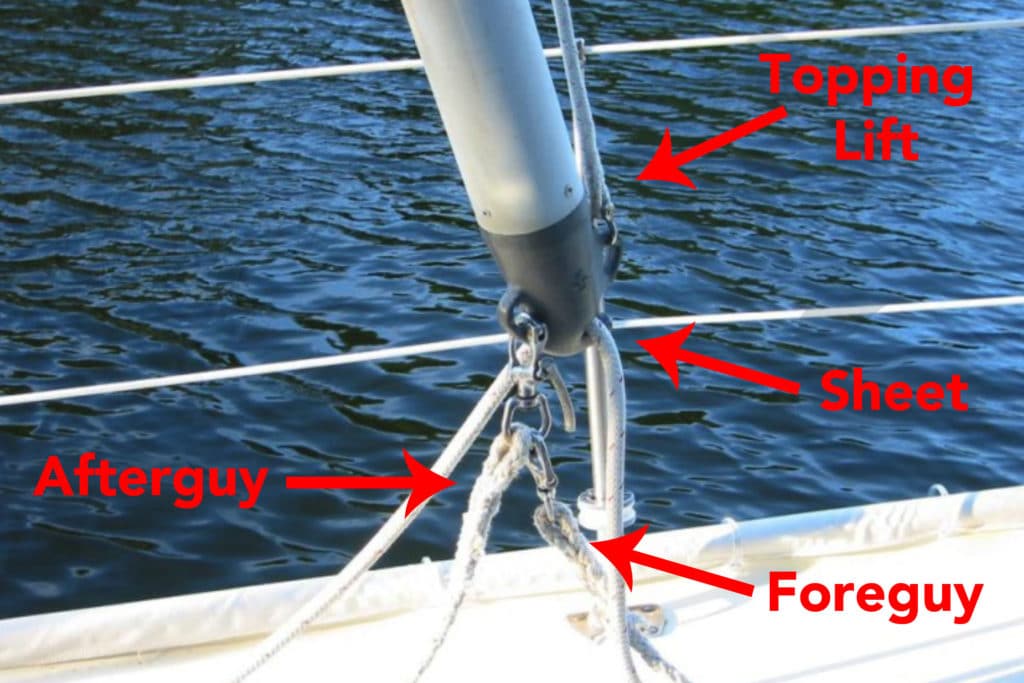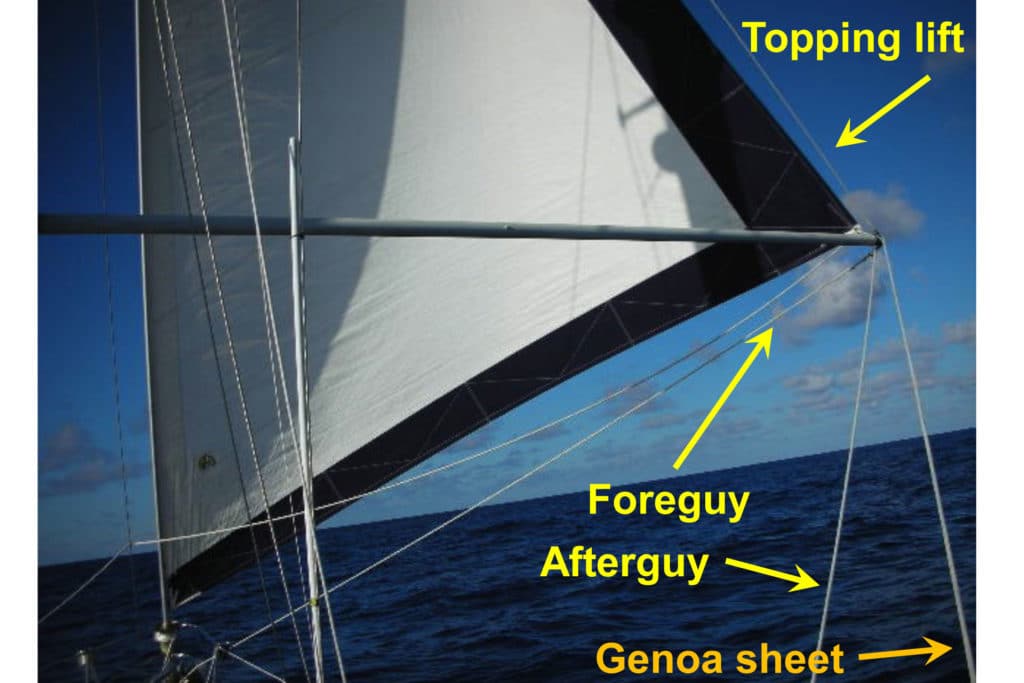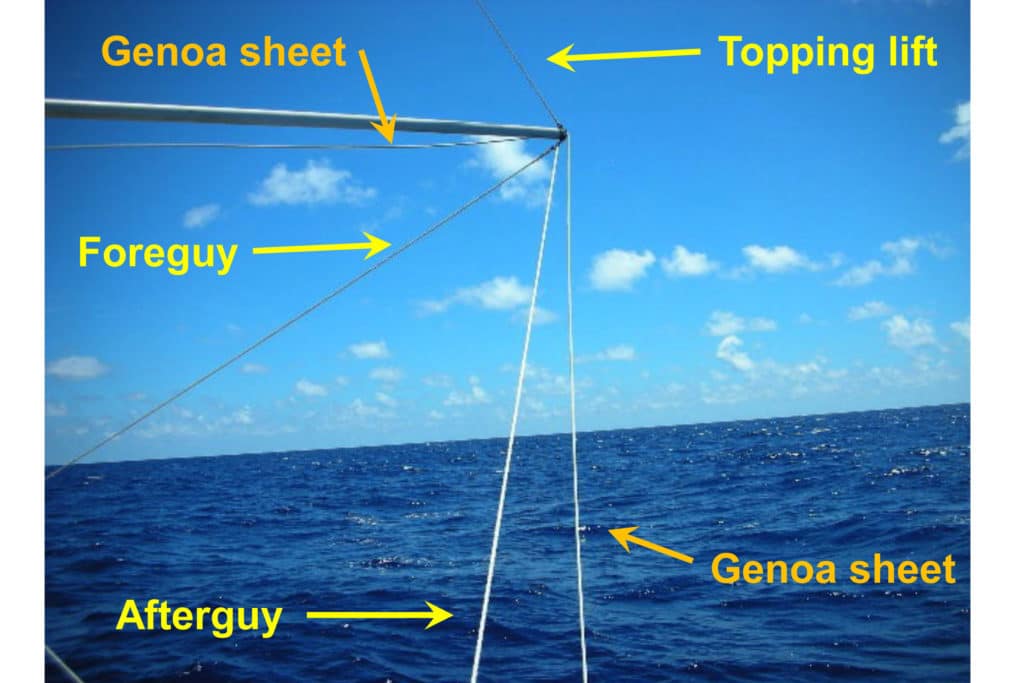Time and again you see people sailing downwind with the genoa poled out to windward, AND the outboard end of the pole is attached to the clew of the genoa! I shudder to think how dangerous this is because the pole is then totally controlled by the genoa and the wind!
There is a better way to do this, and a much safer procedure for deploying a downwind pole when sailing with the wind on the quarter. It is so simple, so easy, and more importantly, safer to use and you are in complete control of the pole from your cockpit.
When getting the downwind pole ready to deploy there should always be an adjustable topping lift for the outboard end. There should be a foreguy attached to the pole’s outboard end that runs from the outboard pole end fitting to a snatch block attached on the stem of your boat, and then led back to a cockpit winch on the leeward side of your vessel. There should be an afterguy that also attaches to the outboard pole end fitting that leads down the windward side of your boat to a cockpit winch. The sheet of the genoa or jib should always run freely through the outboard end of the pole fitting.
Look at the photos above to see how easily this is done. When you set the pole, you should set your spinnaker pole car or pad eye on the mast at the same height as the clew of the jib or genoa.
It is truly much easier to stow a downwind pole, spinnaker pole, whisker pole, whatever you may call it, on a track that runs up the front side of the mast. By having a sliding car on a track installed on the forward side of your mast, you can slide the inboard end of the pole up the mast for stowage when not in use. By installing a T-Track on the front of your mast going up as high as the length of your pole plus another few feet, it is much easier to control the deployment and retrieval of the pole when sailing downwind.
When you control the deployed pole from the comfort and safety of your cockpit, you will be able to furl the jib or genoa if you need to, without bringing the downwind pole back to its stowed position. By allowing the inboard end of the pole to slide down the track on the mast, and controlling the topping lift at the outboard end that already has the foreguy and afterguy controlling the movement of the pole fore and aft, you can triangulate the control lines so the pole will never move.
This will allow you to furl or reef your jib or genoa without having to touch the pole itself. It can remain in place for hours or days when sailing down the trades, and you will be able to gybe over the mainsail and change course if necessary without going near the pole.
Simple Steps for Safer Wing-on-Wing Downwind Sailing:
To Prepare the Pole:
- Install an adjustable topping lift on to the outboard end of the pole
- Have available a Foreguy attached at the outboard end of the pole, through a snatch block at the bow, and back to the cockpit on the leeward side of the boat
- Have an afterguy attached at the outboard end of the pole back to the cockpit on the weather side of the boat.
- Run the jib or genoa sheet through the outboard end of the pole
To Set the Pole:
- As you lower the inboard end of the pole down the track at the same time take up on the topping lift at the outboard end of the pole. By premarking where these should be cleated, it is very simple to set the pole perpendicular to the mast at the proper height of the clew of the sail.
- Once the pole is in place, perpendicular to the mast, parallel to the horizon, and level with the clew of the genoa, tighten the foreguy and afterguys and let the sheet run free. It is best to have the foreguy and afterguy also premarked to where they are cleated off to make this a simple tightening to keep the pole from any fore or aft movement.
To Set the Genoa:
- Then it is a simple matter of pulling out the sheet and cleating it off as it lies against the outboard end of the pole.
- If a squall comes up, and you want to reef the genoa, just ease off the genoa sheet, and ease off the afterguy forward, take up on the foreguy and roll in your reef. If you need to gybe over on the other tack to avoid something like a squall or a ship or a rock on the chart, just ease the sheet and roll up the genoa all the way. The pole can remain in place as the topping life, after and foreguy will not let the pole move. You are in complete control of your genoa.
Look for the next “Pam Says for Hands On Sailor” where I will show how easy it is to install the track, the car, the topping lift and the pole on the forward side of your mast!
Happy and SAFE Downwind Sailing!!!
Pam











